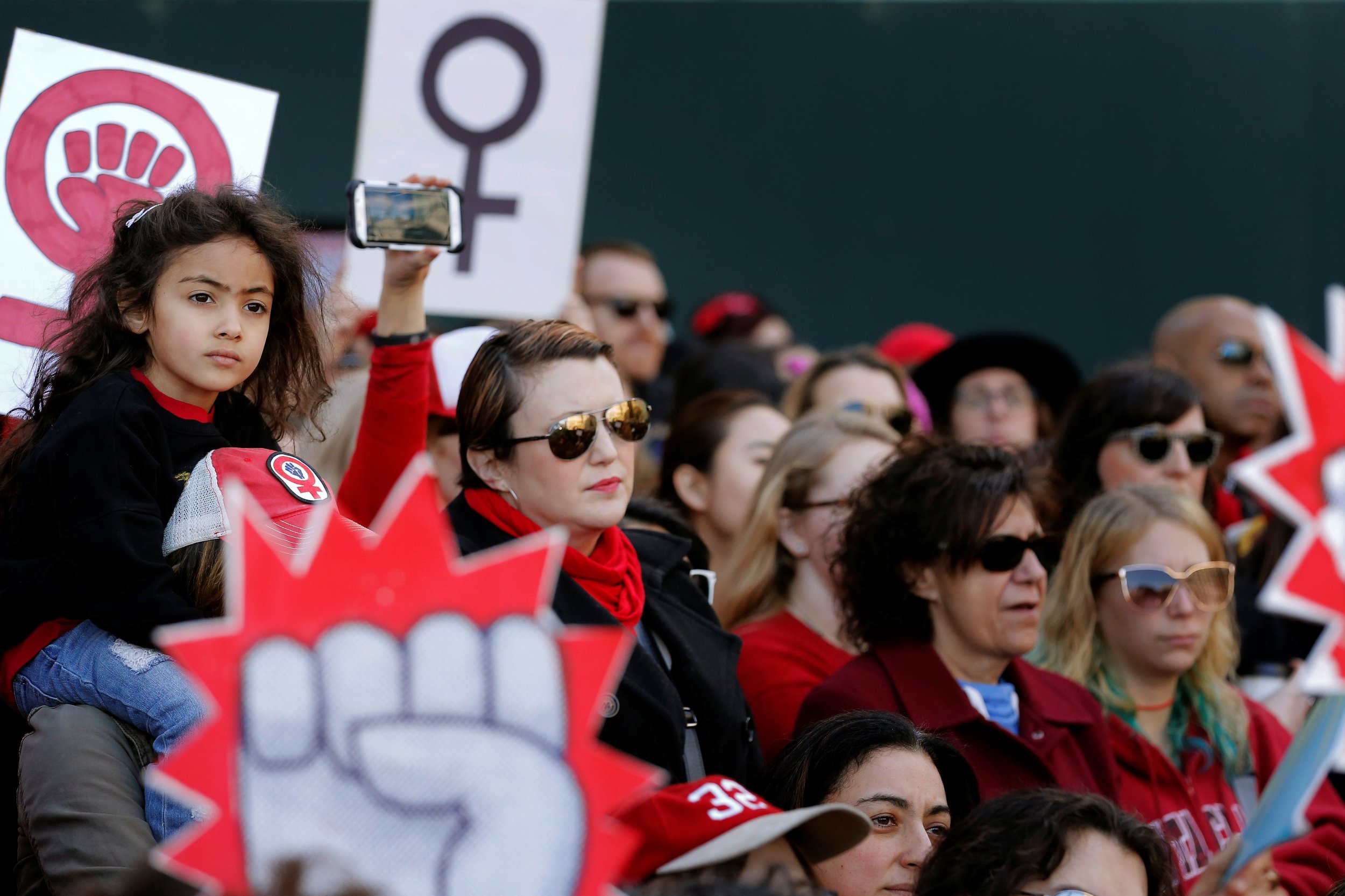
Quora Questions are part of a partnership between Newsweek and Quora, through which we'll be posting relevant and interesting answers from Quora contributors throughout the week. Read more about the partnership here.
Answer from Cathy Yardley, co-author of Geek Actually and eighteen other novels, editor:
In my opinion, the most significant cultural obstacle women face in 2017 is the concept and practice of hegemonic masculinity, especially toxic masculinity, which in turn covers many other cultural obstacles that we're more used to seeing in media, politics, and everyday interactions. From touchstones as important as women's representation in film and TV, or in higher positions of business and government, to microaggressions such as "mansplaining" and "manterruptions", the effects ripple outward.
Let's unpack that, shall we?
What is toxic masculinity?
What popular culture has been calling "toxic masculinity" is not calling all masculine/male gendered/men "toxic". Toxic masculinity is a "brand" of masculinity that is often seen in neo-conservativism, the "Men's Rights" movement, patriarchal religions, and many forms of online trolling.
But even though those groups might represent the "extremes" of the identity, the toxic masculinity that's currently dominant in the U.S., and has been for several centuries here and other parts of the world, is one that is set up to essentially stay dominant in the gender hegemony. While the extreme behaviors of this very specific group are not necessarily the norm in, say, the United States, the stereotypes and symbols perpetuated by this group largely contribute to the framework of hegemonic masculinity that currently contributes to the subjugation of women's rights and their ability to succeed.
What's hegemonic masculinity?
"Hegemony" means leadership or dominance. In R.W. Connell and James W. Messerschmidt's article Hegemonic Masculinity: Rethinking the Concept (Gender Society, 2005) they discuss the idea that there are a lot of different definitions and experiences of masculinity, but one rises to the fore and then fights to remain dominant.
It's not "normal" per-se. It is normative.
The weird thing is, it's not as if the majority of men are running around living up to the toxic ideal. If that were the case, all men would be out there roping cattle, winning Superbowls, or bench-pressing Cadillacs while protecting the delicate womenfolk who stayed at home (or, in worst case scenarios, enduring the violence of said toxic males).
But you don't need a majority. You just need the majority to fall in line.
So how does this kind of masculinity sustain itself?
According to Connell, it requires "considerable effort to maintain." It means keeping all men upholding the party line, even if they don't completely fit it or necessarily agree with it. And it means delegitimizing and excluding any threats from subordinate groups – often women, especially those who don't conform to their ideals of "emphasized femininity", or to masculine identities that they marginalize (LGBTQA, for example, or non-dominant races and ethnicities).
This is accomplished by several other cultural obstacles.
- Idealized masculinity symbols. Think hyper-masculine representations: football players and other sports figures, movie action heroes, etc. Again, not the norm as experienced in everyday life, but pushed to be the "ideal" that men should strive to emulate.
- Gender roles and stereotypes. I'm a feminist. I'm half Asian. I was raised with traditional gender roles, and so was my husband. Since I work from the home and he works outside of it, we've taken fairly traditional roles when it comes to raising our son. So imagine my shock when I confronted my son about cleaning up after himself. "If you don't learn how to do this, what are you going to do when you grow up and move out? Live like a slob?" His response: "Simple. I'll get a wife." Simply by seeing our division of labor, and seeing his friends' parents in similar roles, he had assumed that this was how the world worked. Which leads us to…
- Cultural consent. As long as people remain quiet about the disparities in the world when it comes to the leading form of hegemonic masculinity, they are reinforcing the dominance of the toxic identity. There was a recent article about Veronika Hubeny, a theoretical physicist at UC Davis, who was talked over by the moderator, describing her theories without letting her talk. It wasn't until one attendee shouted "Just. Let. Her. SPEAK!" and the audience cheered in response that the dynamic slowly changed. In an article, the attendee, Marilee Tarkington, said that many attendees thanked her for saying "what everyone here was thinking… what he was doing was horrific." And yet it took ten minutes for anyone to say anything. Had Tarkington remained silent, there is a good chance that Hubeny would've remained sidelined and ignored… and the crowd would've gone along with it, witnessing without protesting.
- Microaggressions. The "mansplaining" described above is a form of microaggression. It's when a man takes over a conversation, and explains something a woman clearly knows in a patronizing and condescending manner. Other examples of microaggressions: men telling a woman to smile (something that would be considered odd for men to tell other men); interrupting ("manterruptions") and talking over; catcalling; reprimands for not behaving "courteously" or in ways that are not considered "appropriate" despite the fact that men behaving the same way are not taken to task. (For example, Senator Elizabeth Warren being silenced for criticizing Senator Jeff Sessions; Senator Kamala Harris being told to be "courteous" during the Russia hearing.)
- Just plain aggression. Kim Weaver, the Democratic candidate for Iowa's 4th congressional district, recently dropped out of the race because of death threats. With the ease and anonymity of social media and the ability to ferret out personal information, there has been a new boldness in outright threats of violence, especially towards women. When women stand up or make comments that the hegemonic masculinity brigade find threatening, they respond with swift and brutal counter threats. These usually take the form of rape and/or death threats. This can be backed up by "doxing" (revealing personal address and contact details to show the victim they are vulnerable to attack, and providing information to those who might act on it by harming the victim) and other malicious acts.
- Representation. Women make up more than half the U.S. population, but they hold only 23% of government offices, per the Center for American Women in Politics at Rutgers University. On June 7th 2017, Fortune Magazine released its "Fortune 500" list, and they reported that women CEOs on the list were at an all time high – of 32. Out of 500. Women made up only seven percent of all directors of the top 250 highest grossing films, according to the San Diego State's Center for the Study of Women in Television and Film… a two percentage point decline from the previous year. Government, business, media representation – all largely controlled by men who set the culture.
So is it hopelessly entrenched?
There is no blanket solution to conquering the current state of toxic masculinity, but I don't feel that it's hopeless. Recognizing and calling out hegemonic behavior when it's seen is a start. Improving representation by actively campaigning for women politicians, supporting women owned businesses, and women-directed films helps, as well. The wild success of the new Wonder Woman movie is an example of this.
Finally, making sure that hegemonic structures don't cascade into femininity's structures. The Women's March had complaints of diminishing and silencing women of color, especially Black and Native American voices. For femininity to make strides, it can't participate in the same tactics of delegitimizing and ignoring as the current toxic structure.
Bottom line: we can do this… and it's worth doing.
What are the most significant cultural obstacles women face in 2017? originally appeared on Quora - the place to gain and share knowledge, empowering people to learn from others and better understand the world. You can follow Quora on Twitter, Facebook, and Google+. More questions:
- Writing: What are the components of great storytelling that apply across various platforms?
- Interpersonal Interaction: What are the dynamics of friendship on a group chat?
- Feminism: What are your views on feminism and equality? Are they both the same?
Uncommon Knowledge
Newsweek is committed to challenging conventional wisdom and finding connections in the search for common ground.
Newsweek is committed to challenging conventional wisdom and finding connections in the search for common ground.
About the writer
To read how Newsweek uses AI as a newsroom tool, Click here.








